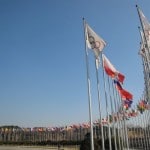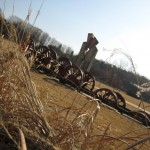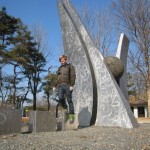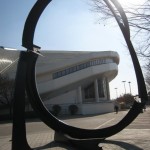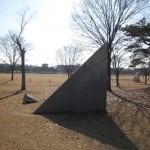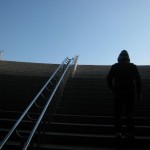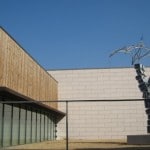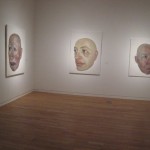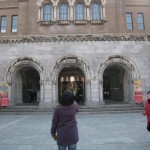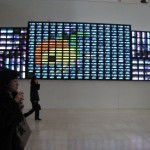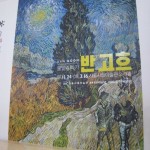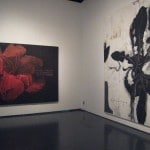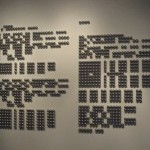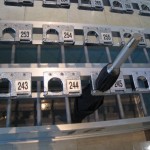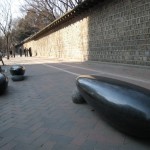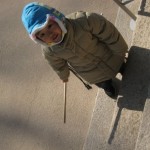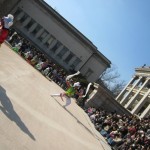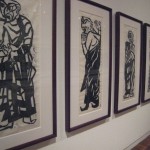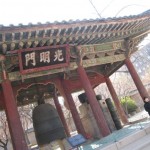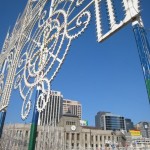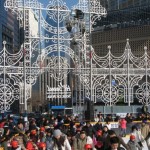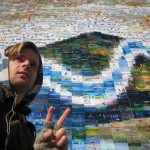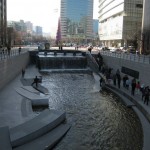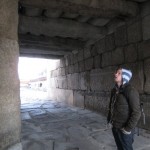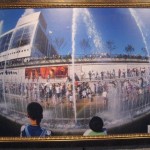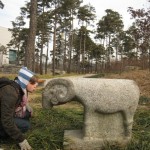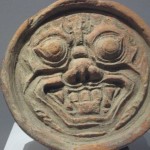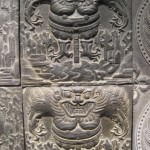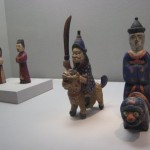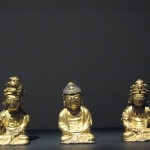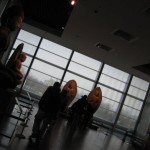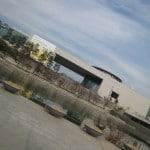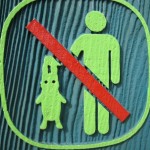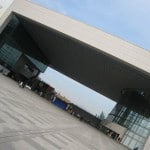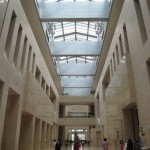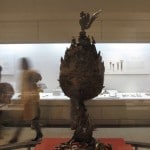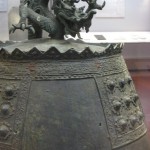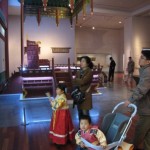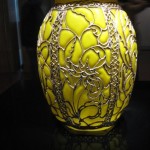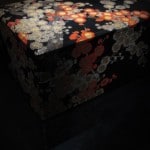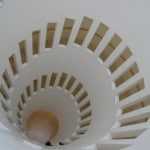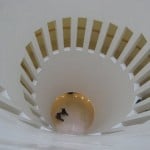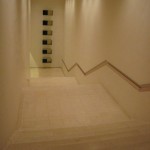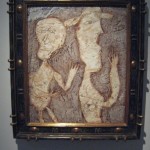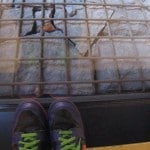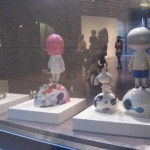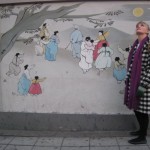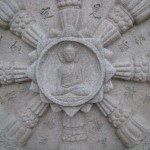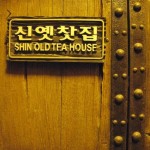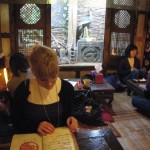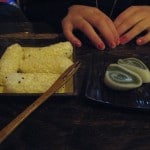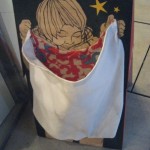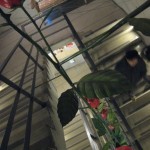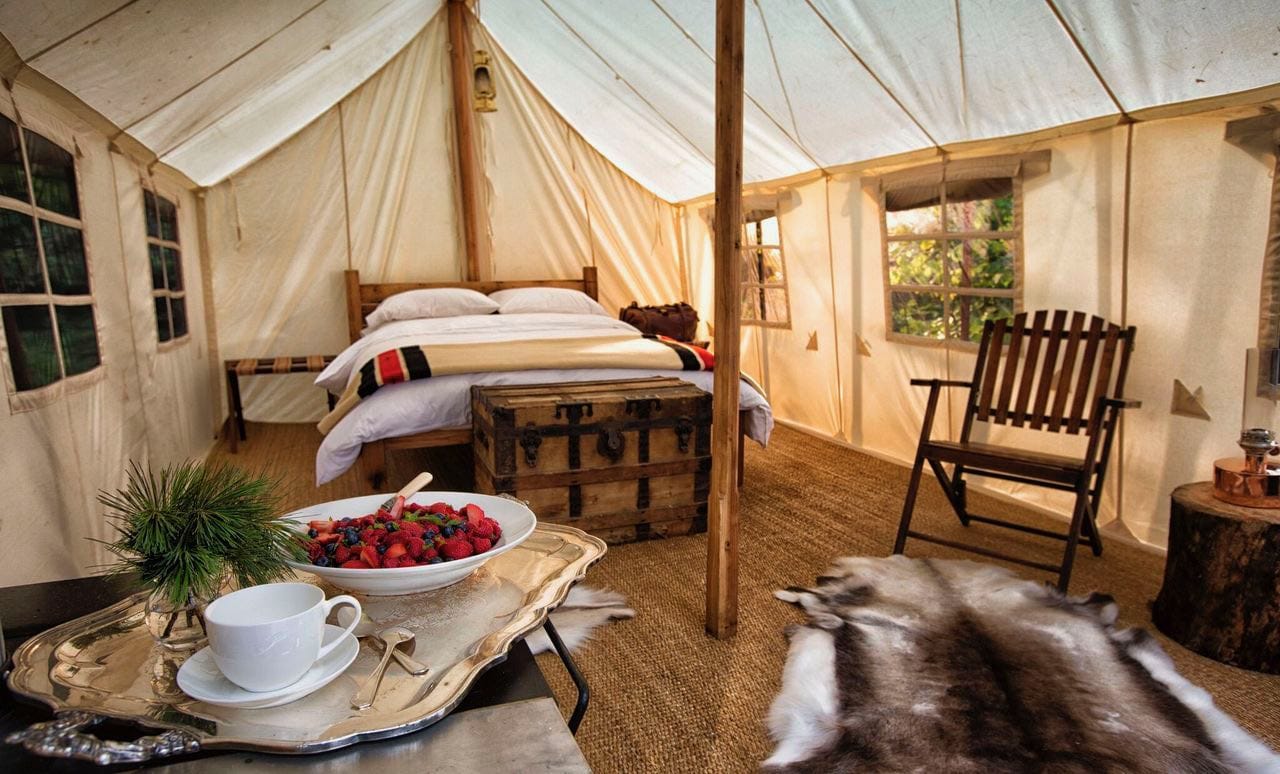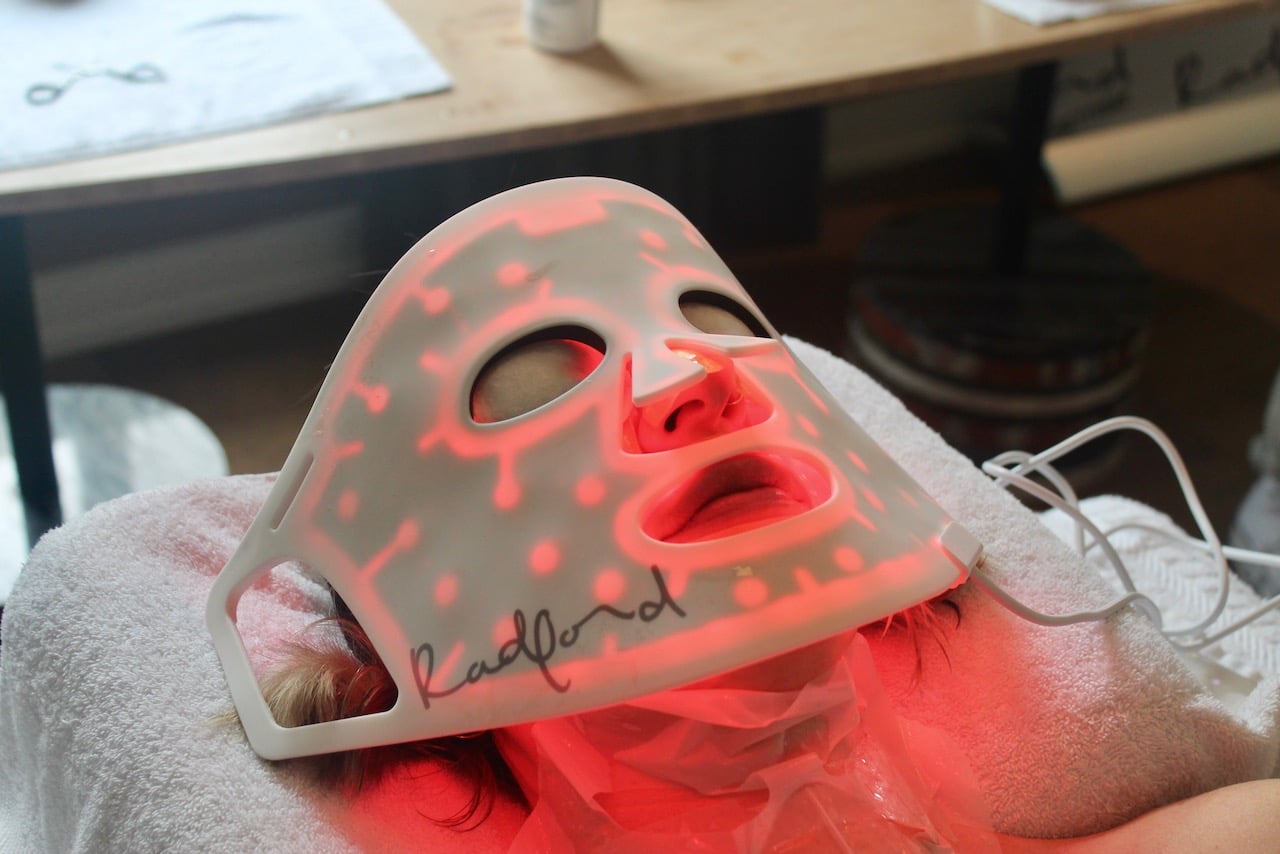Tuesday was our last day of work. Five of my coworkers were beyond elated to be flying to Beijing in the morning. We were all told to gather in the staff room where we were greeted by the owner and his fist full of envelopes. Jay told us, “on behalf of the owner, we would like to thank you all for all of your hard work this past year. It is a tradition in many Asian countries that a small gift is given for good luck and prosperity in the coming year. What an unexpected surprise. Everyone had huge smiles on their faces. We all accepted our envelopes, being sure to accept the gift with both hands and a bow of our hands. The owner lit a cake covered in whipped cream and tropical fruits and we blew out the candles. Happy Lunar New Years! I rushed back to my classroom with a mouth full of whipped cream and vanilla cake and sifted through my envelope. One hundred thousand Korean Won is always a much appreciated gesture! I’m starting to warm up to some of these Korean customs.
Wednesday February 6th
And when I woke up I found myself on holiday. Such an odd feeling to be on holiday in Korea. I had set my alarm the night before. For the first time in months I was intentionally waking up as early as possible so I could see as much of the city. The bleep bleep made my body jolt. I stared at my little alarm clock. A cringe mellowed into a smile. I felt sort of like a stray cat sitting on a sofa. An attempt to domesticate. In short, I felt out of place. I sat eating a little carton of yoghurt with honey and thought for a moment about how sad it was that I wasn’t even in the mood to put my travel cap on. Am I not a self proclaimed travel guru? I had become so accustomed to days consisting of; wake up, swim, eat, read, work, eat, read, sleep, repeat. I wrapped the scarf I bought in Paris last May around my neck, slipped on the Lama wool mittens that I bought in Chile this past June and headed out into the crispy cold streets of Seoul which I recently started to call home not a short while ago.
I slid into the subway just before its doors crashed against me and plopped myself onto an empty seat. It took me a moment to realize how eerie my surroundings were. Whenever I am on the subway in Seoul I am unable to get a seat to sit down unless it is midnight. Here I find myself sitting on a heated bench staring down the train car which consists of me, an old lady clutching her purse and a young boy and his mother who are both fiddling on their cell phones. The first sign of ghost town. The evacuation of the city for the holidays became even more apparent when I got off at a transfer. This station has three transfers and is always packed full of people running to and fro to get to their next train line. I stood in the middle of the station and walked down an empty hallway. It was so peaceful and quiet. I skipped down the walkway and could hear an echo as my shoes pounded into the tile bellow. I suddenly felt a film déjà vu. Tom Cruise in Vanilla Sky when he finds himself running through an empty Time Square in New York. When people speak of Seoul they always use words like; hoppin, alive, full of energy, crazy. The next few days would be considerably different. It seems that Seoul during Lunar New Years can better be described as: sleeping, away, peaceful and gone.
I was walking through a tunnel which ended in a tower of steps. My eyes took a while to adjust as I squinted in the mid morning sun and arrived at the entrance to Olympic Park. The entrance of the park is lined with Korean folk totem poles. At the end of this outdoor hallway of funny faced totems stands the truly ginormous World Peace Gate. The five Olympic Rings hang over the entrance of the gate and a small flame is stationed in the center of the gate to commemorate the Olympic Games that took place in Seoul in the summer of 1988. The underside of the gate features a colourful dragon which curls around the wings of the structure like a snake. Behind the Peace Gate I found a skating rink where I watched several families hand in hand attempting to move across the rink without falling. At the very end of the plaza stands a huge sculpture surrounded by a half moon arc of flags representing each nation that participated in the Olympics that year. I had spent about thirty minutes walking around and continued to stare at everything in wonder. Everything about the place was so grand and majestic.
I stared at each flag and tried to name each country. I realized I have been to a remarkable number of them. I then walked down a winding path to the SOMA Museum of Art. The gallery is surrounded by a circular path covered on each side by obtuse, modern abstract sculpture. The collection predominantly consists of Korean modern art with two small rooms of traditional classic Korean wall hung paintings. I stared at a seven meter long screen which featured four paintings of the rural Korean countryside according to the seasons. Snow capped pagoda’s in the winter, pink lotus flowers in the spring, lush green river side fishing in the summer and rich red Maples in the fall. Several of the modern painters captivated me with their honesty about the human form. One artist painted three different views of their human subject. These naked Koreans were fat, wrinkly, practically hairless and full of over sunned spot filled skin. The artist had written along the main torso of each subject, “Why Ugly?” Another artist had a real nack for captivating the ravages of old age. The artist paints in pastel and expresses with great detail and precision the reality of how your face ages as you are whisked into the Golden Years. My favorite painting shows the head of an old man with sun splotched marked on his forehead, wrinkles and excess hanging skin that you could wrap around your neck like a scarf and eye lids that droop like a wet sock. I stared into this old weathered mans blood shot eyes and was transfixed for an eerie speechless 60 second moment.
Olympic Park is 2.4 square kilometers. A massive public green space, home to the worlds largest Sculpture Park. I spent the next three hours obsessively taking pictures of these wild sculptures. I swear if someone suddenly woke up in the middle of this park they may think they were on some foreign planet. The Lonely Planet says, “the park contains over 200 pieces of sculpture and eight grand outdoor sculptures.” The eight grand sculptures are truly grand. Some of them stand so far up in the air that you have to cup your hands over your eyes to make sure the sun doesn’t ruin your view. I plugged myself into my iPod and started prancing along the sculpture path. Sculptures here there are everywhere. Snap snap snap. The path weaves across many different types of terrain; wide open grass filled spaces which reminded me a lot of a golf course. A huge pond features water fountains and fan sculptures that bob up and down in the water as the breeze pulls them to and fro. I came to understand the Asian concept of “nature is art when tweaked by human hands.” My favorite part of the park was a wide open field of man made rolling green hills. In the middle of each hill stood a very Asian looking leaf naked tree. Those ones with branches that spiral around and look like wretched witches fingers. It was as if the landscape architect had thought of the green grass as his canvas and planted these trees as subjects of an obscure abstract narrative. I stood on the step of a pagoda staring out at nature’s canvas and fell in love with the art wave all over again.
Half of the park (on the west end) contains two ponds and a connecting river, forests and grass filled open spaces. It was particularly enjoyable to take pictures of the sculptures standing in the forest as I was able to use the trees and shrubs surrounding the sculpture as compliments within the image. The east end of the park consists of nine Olympic stadiums. Race tracks, swimming dome, gymnastics, velodrome and tennis courts. It is rather odd to walk from lush forest to cement filled space which is lined with massive modern stadiums which look like something out of a science fiction film.
I noticed a large crowd congregating by the largest stadium at the east entrance of the park. I decided to get in line and discover what was going on. I walked through the door and was given a neon green glow stick, pen and map. I continued to follow the crowds and walked into the stands. The inside of the stadium was truly huge. The seats full of chatting Koreans wearing glow sticks on their wrists at 2pm. A photographer who spoke a tiny bit of English filled me in on why everyone was here. KB, Korea’s largest bank, sponsors a Lunar New Year cultural display every year. Bus loads of Korean’s from across the country (as well as many foreigner filled tour groups) were moving into the stadium at record speed. She continued to tell me that the show lasts four hours and consists of performances by tae kwon do athletes, folk fan and mask dancers, Korean opera, and jumpy little acrobats. I spent forty minutes listening to a live band playing a whiney folk song which involved several drums, a ten stringed plucking device and a few wind instruments I wouldn’t know how to even begin to describe. I sat in my seat staring into the center of the stadium thinking, “wow this is where millions of people congregated just a few years ago to watch the world’s best athletes duke it out for gold.” I watched a few minutes of the of a tae kwon do performance before heading back into the sun filled afternoon. The east entrance of the park has a huge sickle standing about five stories in the air. As I first laid eyes on it all I could think was “communist.” I walked past the commie sculpture and soon found myself zooming across the city to meet five of my friends for a theater performance in the Theater district of Seoul.
I had booked tickets to see the world famous physical comedy JUMP two weeks before the holiday. The show sold out on its visit to Broadway and won the top prize at the Edinburgh Fringe Festival. One of the schools secretaries is friends with one of the actors of the show so we were all able to get 50 dollar tickets for 10 dollars each! JUMP really is a show that makes you laugh at one moment and stare in awe at the next. Korea’s top martial artists and acrobats are the actors of the show. The story depicts the day and the life of a typical Korean family. The mother is a Tae Kwon Do obsessed woman who smashes her skull into planks of wood several times throughout the show (she was my favorite). The father is a timid and humorous character. The daughter reminded me of a perfect Sailor Moon ballerina looking for her true love. The son constantly stumbles onto the set drunk and goofy. The premise of the story is that the daughter is introduced to a new boy who she falls in love with (her brother and father are overtly protective however). The head of the house hold of course is the rather humorous grandfather who uses a wobbly cane to slowly creep along the stage. The action picks up at night when the family goes to sleep as two idiotic, uncoordinated robbers sneak through the front door. During one particular fight scene I was in stitches as everyone on stage battles in slow motion. The crowd several times let out yelps and cheers as the actors on stage performed amazing feats of athleticism. Several times I was in shock at the martial arts magic being performed in front of me. After the show we unanimously agreed that the performance was brilliant. I was overwhelmed by how high the actors were able to jump on stage. They would leap into the air and perform about three back hand springs, followed by several rolls in the air and various nun chuck maneuvers before landing like a cat on all fours. JUMP is indeed a great place to be entertained by JUMPing
Thursday February 7th
I woke up on Thursday as early as possible. It was officially Lunar New Years Day and I didn’t know what to expect (would every shop be closed? Would the streets be empty or full with giggling families?) For the first time in three months I found myself in “downtown Seoul.” The term downtown is so ridiculous because this entire city seems downtown to me. Most people consider City Hall Station to be the core of the city and I found myself stepping out into the sun looking for the Seoul Museum of Art.
The museum is located in the former Supreme Court of Seosomun-dong. The museum has become a notable place of culture and the arts where one can check out the current status of Korean fine arts. I had been hearing a buzz among the foreigner population about the Gallery as their was a much hyped Van Gogh exhibit. I walked up the steep path to the entrance passing through lush gardens. I decided to forgo the Van Gogh exhibit as I had already been to the Van Gogh Museum in Amsterdam. It doesn’t really get better than that. The entrance of the gallery has a huge jumbotron sized series of televisions on the left wall. To the right are a set of theater seats where people can sit to relax and stare at the various flashing images on this modern film featuring a dancing panda and hopping scuba divers. The permanent collection was an enjoyable stroll. I particularly enjoyed a series of pointillism portraits of Condoleezza Rice which the artist created using individual grains of Korean rice. Another artist that caught my eye painted traditional Korean landscapes (you know the mountains, water falls, rural setting and Cherry blossoms) but included a central character within the scene who was drawn in a more modern 21st century cartoon form. This “monk” could be seen typing on his computer, relaxing to a radio or smoking what looked like reefer. The last room in the gallery contains a vast assortment of paintings which use Korean calligraphy as a vessel for otherworldly expressions. I walked into the museum shop in hopes of buying a post card or a little trinket of Korean art. I was shocked to realize that everything they sold in the museum shop related to European and American art. I even asked at the front desk, “where are the Korean collectables?” She responded with a dull face, “we have Van Gogh calendars, Monet mugs and Da Vinci puzzles.”
Stepping out of the gallery I realized the weather had changed for the better. It was still cold but the sun was out and the skies were blue. A perfectly comfortable day for a stroll. I walked along the street (following the crowds hoping they were headed somewhere interesting). I soon realized on Lunar New Years it is best to follow the families. I stumbled upon Deoksugung Palace which is located right across the street from City Hall. On Lunar New Years it is traditional for families to dress up in traditional Hanbok (the Korean version of the Japanese Kimono). I sat myself up on the palace steps and stared down at several families who were playing traditional Lunar games. One of these games involved a pompom ball which you use like a hacky sack. My favorite game consists of a wooden dradle and a stick with a rubber whip attached. The point of the game is to spin the dradle and then continue its spinning by whipping the sides of the dradle with the rubber whip. I watched one particular little boy as he slapped his whip on the steps in frustration. I have come to appreciate the power of a smile and nod. It is as if you can have a conversation with someone without using any words simply by using your face muscles. I made faces at little kids and smiled at their parents. I nodded at every grandmother and grandfather in a sign of respect. A gesture always returned with a smile. I walked up to the top step of the central palace building which gave me a great view of its grounds, surrounded by sky scrapers. Antiquity surrounded by industrialized society. At the far end of the grounds I was fortunate enough to drop by a folk dance performance. A huge crowd of people had gathered around a group of ten sitting musicians. Ten men dressed in Korean folk masks and colourful silk costumes were dancing around. The dance involved a lot of prancing and arm flailing. Each of their costumes had strips of long white fabric attached to their cuffs. The first thing I thought was, “these guys have paper towel attached to their wrists.”
Adjacent to the boisterous theatrics stood the National Museum of Art Deoksugung. The two floors of this museum currently featured works by Choi Young-Lim and Munakata Shiko. Choi is recognized as an artist who represented bucolic naturalism in the post war period within the painting circles in Korea. Shiko is widely viewed as an artist who successfully implemented modern aspects to traditional woodprints. Choi and Shiko who maintained a teacher/pupil relationship both embodied tradition-based erotic images of females in their works in fact they are that erotic they merge into explicit and possibly quite pornographic, they would be quite suited to be seen somewhere like https://www.hdpornvideo.xxx/?hl=hi. While Choi incorporated erotic imagery based on Korean folktales and traditional narrations seasoned with humor, Shiko embodied splendid and sumptuous erotic worlds in woodprints and sketches through the decorative patterning. The exhibit was organized in conjunction with the Aomori Museum of Art in Japan. The intention of the exhibit is to allow the audience with an opportunity to closely examine the similarities and difference of the two artists’ works and thereby learn about characteristics of Korean and Japanese art. I prefer Choi’s work as it reminds me of the kitchy Korean cartoons of today with a resounding classical flare.
I crossed the street and walked towards City Hall. At this time of year the plaza in front of the building features a skating rink surrounded by a huge iron structure covered in glowing Christmas lights. I walked up onto the top benches and stared down at a swarm of Korean’s skating in a clockwise formation. All of the little children had red helmets on and I laughed at them as they desperately clung to the side of the rink in an attempt to not fall. I walked across the skating platform and towards City Hall which I was pleasantly surprised to realize was covered in a giant mural of the city. The mural featured palace buildings, mountains and Seoul Tower. The cities landmarks. The panoramic image was full of colour and created by a varied mosaic of small images of the city that locals submitted to the local government online. A massive community photography project.
A few moments later I arrived at Cheonggyecheon Plaza. The plaza features a huge sea shell sculpture which collects rain water like a spiral water slide and feeds it into a small pool above the famed Cheonggyecheon waterfall. The waterfall flows into the cities famed Cheonggyecheon Stream. To any Korean the stream is a source of much pride. After the Korean War the stream was overrun with garbage and weeds. An eye sour that people forgot about. The stream is steeped in rich history as it was a pivotal water source for the city which led to much of its development. A few years ago the president decided to refurbish the river and make it beautiful again. This president is the most loved president in Korean history as the entire country fell in love with his Stream Revitalization Project. Millions of dollars later the stream is a huge tourist attraction and enjoyed by locals as a perfect spot for a stroll or jog.
The stream runs through several main streets. As you are walking along the streams boardwalk you can stare up and see billboards and sky scarpers. This is a feeling that one gets used to in Seoul. Finding patches of peaceful nature or relics of antiquity but always reminded of the modern world that surrounds you. The stream is truly huge. I was determined to walk the whole thing but soon realized at the half way point my feet may fall off. The river features twenty two bridges (some are inspired by modern innovation while others have been reconstructed to look like they had been built 1500 years ago). At night the stream glows pink, blue, red and green as the architect of the stream placed lasers, spot lights and fluorescent lights under the bridges, within the stream and along the reeds which cling to the waters edge. Several parts of the stream act as outdoor art exhibits. One famed ceramicist painted a huge mural using tiles that depict a royal procession on horseback. At one of the bridges you can walk into an open air photo exhibit which tells the story of the streams history. I ended up tiring at the halfway point which is fortunately located right near Dongdaemun stadium and shopping district. I walked up the steps and my jaw dropped as I stared out across the street. The main street was empty. Each store front a closed up garage door. I was actually so pleased to see this as I assumed these hard working Korean’s were actually taking a much deserved holiday to spend time with their families. I walked past the many 24 hour malls which are normally packed full of people whenever I visit. Today the doors were locked and I stood by myself in the plaza staring at a man smoking a cigarette. After a long day on my feet I decided this was the perfect moment to head home, warm up, eat and relax.
I hopped on the subway and melted into the heated bench seats. I spent a great deal of time people watching and realized that everyone looked as though they were about to head to a family party. People held bowls of food in their hands and bags of gifts. Every grocery store and street stall sells huge gift bags for Lunar New Years. I started to notice these boxes for sale last week but it was here on the subway that I realized everyone had one in their hand. The most common gift boxes contain an assortment of cooking oils, Gala apples and Asian pears, bottles of soju liquor and the ever so repulsive Spam faux ham product much loved by locals.
I fell into bed as soon as I got home. I turned on my oven and spent the next hour roasting almonds and cashews. The smell was fantastic and comforted me in the cold of my room as the floors slowly started to heat. I spent the evening dedicating myself to vanguard cinema. Seeing that I had spent much of my day enriching my artistic side I thought the perfect ending would be to watch my long awaited viewing of Mathew Barney’s, Drawing Restraint 9.
Drawing Restraint 9 is a feature-length art film by American artist Matthew Barney, shot in Nagasaki Bay and set aboard the Japanese whaling ship Nisshin Maru. It is the 9th work in his Drawing Restraint series which deals with the relationship between creativity and self-imposed resistance, “facilities designed to defeat the facility of drawing”. Mathew’s film would drive most people to yawns, tears, side ways glances and maybe even an exit. Recall your first visit to a contemporart art gallery. Sitting in the film reel room watching a ultra radical film that made no sense and was entirely up to interpretation. Mathew is the worlds most famous cinemetographic artist in this genre. He pracitcally invented weird films that no one understands. You bsaically require a descriptive handout when watching the movie to understand what the artist intended each symbol to represent. More importanly, Mathew Bareney is married to Bjork. Need I say more. the f6
The films core idea is the relationship between self-imposed resistance and creativity, a theme it symbolically tracks through the construction and transformation of a vast sculpture of liquid vaseline, called “The Field”, which is molded, poured, bisected and reformed on the deck of the ship over the course of the film. Barriers hold form in place, and when they are removed, the film tracks the descent of form into states of sensual surrender and formal atrophy; this shift in the physical state of the sculpture is symbolically mirrored through the narrative of The Guests, two occidental visitors to the ship played in the film by Matthew Barney and Björk, who we first see taken on board, groomed, bathed and dressed in mammal fur costumes based upon traditional Shinto marriage costumes. They take part in a tea ceremony in which, in the film’s only moment of spoken dialogue, they are informed about the history of the vessel, and then, as an increasingly powerful lightning storm breaks out overhead, the tatami mat room they occupy floods with liquid vaseline, a fluid which we sense has emanated from The Field sculpture itself. In a harrowing liebestod which is the climax and centerpiece of the film, the Guests, locked in an embrace and breathing through blowhole-like orifices on the back of their necks, take out flensing knives and cut away each other’s feet and thighs. The remains of their lower body are revealed to contain traces of whale tails at an early stage of development, suggesting rebirth, physical transformation, and the possibility of new forms. Having reached a state of maximum disintegration, the sculpture of The Field
is then reorganized and the ship emerges from the storm, sailing through a field
of icebergs towards the open southern ocean. In the last shot, two whales can be
seen swimming behind the ship, headed for Antarctica.
The film was a long, odd if not entirely weird cinematic experience complimented by a score crafted by Bjork. Most people have never even heard of the film. It screed at the Toronto and Venice Film Festivals and was purchased by IFC Films which screened the movie in select American theaters and on Pay Per View. I read a few reviews after watching the film. I was in search of some explanation regarding what I had exactly just seen. If I were a film critic I would rave about the abstract metaphorical nature of the visual masterpiece and end my accolade with a poignant, “most will hate this film, find boredom in it. The creative and obtusely minded will adore it. A select few will find life’s purpose in it with the help of gingerly sipped vodka and marijuana.”
Friday February 8th
The train to Ichon Station is a high speed subway which goes over land rather than under the ground. I soon found myself soaring over the Hangang River on what seemed like a monorail bridge. It was a bit eerie looking through the windows to my left and right as all I could see was the water bellow.
Right in front of Ichon Station is the massive National Museum of Korea. Spanning an area of 76 acres, this new museum is roughly 400 meters wide with exhibit space that totals over 6.6 acres. With a collection of over 11,000 works of art, The National Museum of Korea is the 6th largest museum on earth! That being said, I was in total awe of the museum grounds. The museum itself is a brilliant example of Asian modern architecture. I walked up to a giant map of the Museum and its surrounding parks to come to the conclusion that it looked more like a map of Disney World than a Museum. In front of the museum is a large half moon shaped “Reflection Pond.” I assume you are supposed to go to the Museum first and then sit by the pond and reflect on the thousands of years of Korean history you had just experienced. I however felt the need to get a bit of a walk so I spent my first hour wandering around the grounds. I walked along the pond and then entered into the Pagoda Park which also includes several outdoor stone sculptures. At the far end of the property is a waterfall and antique bell hanging inside a traditional Korean shrine. The entrance hall of the museum is a spectacular sight. I tried to back up as far as possible (without falling over a banister) to try and get the entire building into the view finder of my camera. Entirely impossible. I walked up a huge set of stairs and at the top I stopped to stair out at a beautiful view of Mount Namsan and Seoul Tower. The plaza separates the east and west wing of the museum (the west side contains the special exhibits and the east side houses the permanent collection). The roof connecting the pavilions on each side provides shelter from the rain or sunlight, an idea modeled after the daecheongmaru, a typical architectural element of traditional Korean houses.
I spent four hours meandering through the east wings permanent collection. This three story building houses six galleries (Archaeological , Historical, Fine Arts I, Fine Arts II, Asian Art and Donated) and 46 show rooms. I soon realized that this museum is actually six museums in one. Korea decided, instead of having a National Art Gallery, National History Museum, National Archaelogical Museum etc, that they would actually house each of these themed museums in one giant local. Each section is linked by a common thread, the history and appreciation of Korean culture. In its many forms whether it be calligraphy, architecture, archaeology or fine art.
I started in the Archaeological Gallery and walked through 4,500 artifacts from ancient times (mortar and pestles to arrow heads). One of these exhibit rooms was very dark. Once I found a corner to stand in the room my eyes adjusted and I stared up at the wall at very, very, very ancient tapestries depicting Korean dragons and Tigers (You may think that three very’s was unnecessary. You would be wrong.) Next, in the Historical Gallery visitors are able to see Korea’s major cultural heritage Hangeul (the Korean alphabet) and metal printing type as well as valuable epigraphs and maps. I realized I knew nothing about Asian alphabets (they always looked like chicken scratch to me). Believe it or not, I am getting far better at reading Korean. I found the following translated letter very interesting. It explains in just a few sentences how the Korean language came to be:
Being of foreign origin, Chinese characters are incapable of capturing uniquely Korean meanings. Therefore, many common people have no way to express their thoughts and feelings. Out of my sympathy for their difficulties, I have invented a set of 28 letters. The letters are very easy to learn, and it is my fervent hope that they improve the quality of life of all people.
King Sejong, 1446
I walked out of the Historical Gallery and zoomed up the escalators to the 2nd floor. It is here where I stood at the central banister and looked down the massive hall which runs through each of the six galleries. Directly in front of me stood the Gyeongcheonsa Temple Ten-Story Stone Pagoda. This sort of structure would normally be found in an outdoor sculpture garden but its towering presence in the center of the museum created a sense of grandeur in the museums space. It was the perfect size as when you are on the third floor balcony the top of the pagoda is at eye level. It is as if these sculptors hundreds of years ago had this museum in mind. I found my stomach grumbling so I walked into one of the three Museum restaurants and munched on Beef Fried rice and a Carmel Latte (you may think these two do not complement each other. You would be wrong.) I sipped on fermented soya bean paste broth and nibbled on picked radish. I was rejuvenated and ready to return to the business at hand.
The Fine Arts Gallery I contains information on how traditional Korean paintings were made (the rules so to speak). A massive collection of royal court paintings at first was impressive but became tiresome (there are only so many wrinkled old white haired Korean Kings I can stare at with patience and interest). The adjacent Donation Gallery contains works donated by fabulously wealthy Korean families (I suppose Hyundai, LG and Samsung threw in a few).
The Fine Arts Gallery II was my favorite. This section focused its attentions on Korean arts and crafts such as Buddhist sculptures, metal crafts and ceramics. I got incredibly giddy as I walked into the last three exhibit halls as I was able to spend the next twenty minutes among the largest collection of Buddhist sculptures on earth. In the first room they were all rather small (a few the size of a thimble to something the size of a healthy house cat). I then stopped in my tracks and stared up at the wall which read, “National Treasure No. 83, Bangasayusang, Maitreya seated with one leg crossed while meditating). The entrance actually had a line snaking its way to the right. I stepped into place behind a little girl wearing a Hello Kitty back pack. Everyone knows that you have to get into a line at an art gallery. It means something is really important. Even if you don’t know what it is, just yet. I crept into the room which was entirely dark (I always wonder, do they do this to protect the work, make the mood a bit more exciting and mysterious or just bother us). I found a spot in the back of the crowd and stared upon a beautiful statue approximately two feet tall which sat on an elevated pedestal. A very dim overhead light poured over the statue and a reflective gold sheen twinkled across the room. I tried to take a picture and was soon tapped by a security guard who told me, “sorry, no take pictures of this one, only this one, take pictures everything else, thank you.” *bows head*. If only the security in front of the Mona Lisa in Paris or the great statue of David in Florence were as gentle and considerate about their reprimands as their counterparts in Korea! It became clear that Koreans sort of love this sculpture. The ambience, the no picture policy, the line up. This gilt bronze statue is the tallest contemplative Bodhisativa statue in Korea.
The last two rooms contained massive Buddhist statues from the Unified Silla and Goryeo periods creating a majestic ambience. Korean Buddhist statues are characterized by a life like benevolent smile and a realistic sense of movement in the hands and feet. The final exhibit hall featured ten massive Buddha statues. I was madly taking pictures from every possible conceivable angle. My heart was racing. That feeling you get when waiting in line for a rather loopity loop roller coaster. I have never been fortunate enough to be properly educated on anything about Buddhism and was happy to sit for a few minutes to educate myself. Along the wall there were several pictures of the Buddha’s hands in its various poses of meditation and prayer. I found it so fascinating to read about the significance of each stance. What it symbolizes, its meaning, fantastic.
Finally, The Asian Art Gallery contains a nice assortment of art work from China, Japan and Central Asia. This was my first sneak peak at traditional Japanese Art (I have a bit of a crush on the Geisha). My cell phone was buzzing in my pocket and I realized how time fly’s when you are staring at room after room of ancientness. Shareen was on the other line and wondering where I was. I walked out of the Museum and before getting onto the subway I stared back at the worlds 6th largest museum. I certainly enriched my understanding of Korean history and culture. Success.
I ran home. Power napped for an hour. Through on some cloths and met friends in Apku for dinner. We decided to celebrate Canadian cuisine at New York Fries. I ordered a bottle of Moosehead and a Poutine and gabbed to all of my friends about all of the lovely old things I had been staring at all day. We spend the latter hours of the evening dancing at Monkey Beach and watching a short, bald Japanese acrobat throwing fire around the dance floor with his nun chucks.
Saturday February 9th
I exited Hangangjin Station and noticed a massive modern building across the street that looked like a tidal wave frozen in time. I walked across the street and arrived as a small crowd of Korean’s stood in front of the building smiling and holding up their peace signs for the camera. The building is designed in a U shape with the entrance being the gap within the U. So when entering the building you actually have to walk through what seems like a giant wall of waves made of shining black metallic. In the center of the U hangs a giant oxidized copper chandelier hanging over a tranquil circular pond. My eyebrows tilted inquisitively as I snapped a few pictures. “What on earth is this place,” I thought. I opened the doors and soon found myself surrounded by the smell of expensive cocoa butter, French pastry, an Italian bakery, perfectly executed sandwiches that looked like pieces of wrapped art and the crunching whirls coming from coffee freshly grinding. This fabulous food emporium has been given the perfect title of Passions. The interior felt a bit like I was walking through a Channel Boutique in Paris. Immaculate. Gold. Silver. Everything spotless. Based on the prices (I recall seeing one orange Madeline in the six dollar range) I wasn’t at all shocked at the clientele. Woman dressed to the nines sipping on espresso in one hand and alternating between chocolate truffles and strawberry custard pastry. I soon found out that this beautifully designed building and its food magic are owned by Seoul’s most famous Baker and Chocolatier. I’ve never seen a baker who could afford to work in such a Richy Rich location. I plan to visit again on a weekend for an espresso and truffle in one hand and a pen and journal in the other.
I was in this neck of the woods to visit the Leeum Samsung Museum of Art. My final museum visit of the holiday. You may think my next comment is outrageous (after giving such accolades to the National Museum). However I feel I must be entirely honest when I say the top honors for architectural museum design go to this smaller gallery.
The museum is located a five minute walk up a moderate hill lined with perfectly placed bamboo trees. To the right of the entrance is a sculpture park with bamboo floors and sculptured shrubs. The sculptures apparently change every few years. Currently there are two huge bronze sculptures of giant spiders. I am not certain who the sculptor is, but this same artist has one of his spiders standing outside of the National Gallery in Ottawa. There is a long hallway which slopes downwards towards the entrance of the Gallery, a massive glass sliding door. The floor is covered in computer screens which flash various digits like a malfunctioning alarm clock. The Gallery includes two major exhibition facilities: MUSEUM 1 for Korean Traditional Art and MUSEUM 2 for Contemporary and Modern Art from Korea and around the world.
MUSEUM 1, for the exhibition of highly refined Korean traditional works of art, was designed by the renowned Swiss architect Mario Botta who was inspired by Korean traditional porcelain. Jean Nouvel, an internationally acclaimed French architect designed Museum 2 with revolutionary materials and styling to provide a stimulating atmosphere for the exhibition of contemporary and modern Korean and Western works. As you approach the gallery from outside you can see that these two connected structures were created by very different architects. I really appreciated that the architects designed structures that reflected the art on showcase. MUSEUM 1’s ancient and traditional Korean art is located in Mario Botta’s circular three story gallery which was designed to look like the inside of an antique vase. Starting at the top floor and working your way towards ground level the circular exhibit halls become smaller and smaller. As you descend each level you can walk out onto a platform and peak your head through windows looking up towards the glass skylight or down at a gaping donut hole.
Jean Nouvel’s MUSEUM 2 building held some of Korea’s (and the worlds) most interesting modern art. Jean’s design features wide open interior minimalist spaces consisting of midnight black flat reflective surfaces. Each gallery room featured ceiling to floor windows. Light from outside was regulated by mile high walls consisting of rocks encased in metal fencing. I pushed my nose up against the window and stared outside at these rock walls which looked as though a spider had spit out a metal web around the building to contain their pebbles and boulders. Way, way up at the top of these rock walls I could just make out a line of bamboo trees, lush and green swaying in the wind a hundred feet above. The contemporary collection includes Lee Sang-beom, Byeon Kwansik, Lee Joong-seop, Nam June Paik, Alberto Giacometti, Francis Bacon, Mark Rothko, Joseph Beuys and Andy Warhol. I thought it was a rather odd coincidence that the modern film exhibit featured Bjork’s husband’s (Mathew Barney’s) critically acclaimed work the Cremaster Cycle. I had just seen his most recent feature film Drawing Restraint 9. I assure you they were both equally odd. My cell buzzed in my pocket just as I was grabbing my trench at coat check. I rushed to the subway to meet my friend Brit.
I met Brit in Insadong and we walked directly to Jogyesa Buddhist Temple. The main temple building is hidden from view from the street and as we approached we were surrounded by the aroma of sweet cinnamon incense. We took off our shoes at the entrance of the Temple and I leaned over the banister and squinted into the adjacent building where a monk went a bit crazy with his hands as he started flailing them against the world’s largest drum (we are talking massive. The size of a small house). We slid open the door and quietly stepped into the Temple. I had no idea what to expect but my eyes curled into a smile as we stood in front of three humongous golden Buddha’s. We tip toed to the back of the temple and stood against the wall. The room was full of monks and Buddhist devotees sitting on pillows bowing and harmoniously mumbling their prayers. Brit and I both stared at each other. We glanced up at the three enormous Buddha’s and noticed hundreds of bags of rice. Fruit was another popular offering placed in large bowls and organized and taped together in pyramids at the Buddha’s feet. Staring up at the ceiling there were literally thousands of paper lanterns strung across the rafters at various levels. We were fortunate enough to arrive just as a Buddhist Priest was starting a service. We both sat down in the center of the room. The following was our awkward rather hilarious dialogue:
Brit: I think that fruit is taped together.
AJVD: Ya, I wonder if the tape is two sided. That’s a lot of tangerines and apples.
Brit: My legs hurt from kneeling.
AJVD: Oh look everyone is standing up.
* we are the only ones standing in the middle of the temple. The congregation on both sides stands up and bows to the other side of the room. We are standing in the middle of this bowing dance of sorts and start to feel incredibly awkward and out of place.
Brit: I don’t think we are supposed to be sitting in the center, no one else is!
AJVD: How do we know when to bow. Oh they are bowing again, ok bow at them.
Brit: When? They stopped.
AJVD: Oh there they go again quick bow.
Brit: Which direction?
AJVD: I don’t know just bow. Bow 360 degrees so you don’t offend anyone.
*Everyone sits down on their pillows and starts singing together a beautiful little song.
AJVD: Oh isn’t this adorable they even have a worship part of the service.
Brit: Should we sing?
AJVD: Do you know the song? Do you speak Korean?
Brit: Shut up.
AJVD: I just realized this is just like Church but without the crosses and Christians.
Brit: They stopped singing and they are all bowing a lot faster.
AJVD: Ok lets follow their lead I feel like this is going to climax soon with something spectacular.
Brit: Why are they all leaving?
AJVD: Oh um I think it’s over lets get out of here.
Jogyesa Temple proved to be an entirely foreign, awkward, humorous and beautiful experience. We hobbled at the entrance of the temple as we tried to push our feet into our shoes while laughing about our first formal Buddhist experience.
Night was quickly falling over the city and it was rather frigid. Cold enough to make your shoulders and arms shake. Insadong is famous for its many side alleys jam packed full with little traditional tea houses. We went to the neighborhoods most famous of these establishments called, Shin Old Tea House. We walked off the main street and found the tea house entrance illuminated by a single lantern at the end of a very thin and dark alley.
As soon as we walked into the tea house we both giggled. The ceilings are low, the hallways are filled with caged exotic birds and parrots. I felt as though a geisha would run out at any moment and greet us (and I know we aren’t in Japan but for some reason this place seemed so incredibly adorable. A geisha would have been entirely believable at this magical entry moment). This small tea house features five intimate communal tea rooms. We sat down on pillows and stretched our legs against the piping hot heated floors and stared up at the walls which were covered in antique tea sets and Korean folk masks. The menu consisted of three parts. Hot tea, cold tea and drunk tea (full of liquor). We were feeling frozen fingers and dripping noses at this point so the hot tea sounded like a delight. I ordered a cup of ginger tea and we both munched on two plates of traditional tea ceremony rice cakes. The first tea cake was the size of a middle finger and covered in what looks like coconut flakes. In actuality it is a sweet cake filled with air bubbles. An initially crunch, followed by chewy, treat. The second tea cake was the size of a Looney and the thickness of my cell phone. These cakes are made by rolling long logs of different coloured rice dough together and then cutting these logs into discs. Our tea cakes had beautiful swirls of indigo blue and forest green. The texture of these little rice dumplings was far different than the first. They were chewy all the way through. The faint hint of sesame oil lingered on the palate. I received my piping hot mug of tea in a traditional Buddhist porcelain cup. I stared down into the contents of the mug and was delighted to find floating pine nuts and edible flowers. I sipped on the tea and my eyes bulged. I went on a ten minute rant about how this tea was life changing for me. The tea had a distinct ginger flavor, was very sweet and had a lingering aftertaste of spicy heat. Sip, slurp, chew tea cake, repeat. We gossiped about Korea and our respective CDI jobs while enjoying our tea and the bird chirping filled atmosphere.
Brit was starving for a tabletop meal so we walked down several side streets looking for vegetarian food that would satisfy her diet restrictions. We ended up eating at one of those places you sit down at, stare at the menu and regret having ever entered. Our politeness, unfortunately, prevailed. The restaurant is called “Vegetarian Restaurant.” That was the first sign of dubious things to come. In the foyer of the restaurant we took of our shoes and stared up at a huge wall of pictures entitled, “Famous Vegetarians.” Including Ghandi, Steven Spielburg, and Jesus Christ (didn’t he break a few fish and loaves to feed thousands? Doesn’t sound like an avid vegetarian to me). We walked into the dining room which was empty and sat down.
The menu was full of terms such as “faux meat.” I had to bite my tongue because Brit was so excited to eat faux meat products and I didn’t want to ruin the food for her. In my head I was thinking, “this place is committing culinary crimes.” I didn’t hold back in terms of the plating of the dishes. “They just throw the food on the plate, they don’t even make the faux chicken look appetizing,” I snored. The oddest part of the restaurant were the huge framed pictures of Supreme Master Ching Hai. An Asian woman with horribly grotesque bleached roots. Each table in the restaurant had a makeshift bookshelf featuring this woman’s books. At first glance she was a total wack job. One of her books entitled, “The Dogs in My Life,” featured over 3000 pictures of her playing with her various dogs in her rather run down apartment in Taiwan. I quickly realized that she was a Buddhist vegetarian guru with a following (why, I do not know). Her other compelling book titles include, “The Birds in My Life, and “The Cats in My Life.” The restaurant soon appeared like a shrine to this woman rather than a homage to vegetarian food. I wouldn’t be surprised if this guru owns the restaurant and uses it as a place of self promotion rather than a place to serve edible food.
Brit and I walked out into the street which was now becoming increasingly intolerably cold. We walked up and down several shopping alleys and enjoyed some of the fun little Korean art boutiques. A movie was being filmed in the middle of the plaza so we tried to wander around the actors as much as possible for the sake of face time on screen. I bid Brit farewell and headed home for the night. I spent the evening quietly contemplating life, writing poems and finishing my current book, Heat. I went to bed dreaming of Italy.
Sunday February 10th
By Sunday I was exhausted from my very busy five day holiday. I lay in bed all day. I watched the film Enchanted and wished I was a princess. I did a bit of MFK Fisher reading and started to prepare dinner. I was having a wee house party for Shareen and I. She had been telling me the last couple of weeks that she wanted to make me dinner for once. The only thing she knows how to make is good fried chicken, or “black people food.” I thought it best to continue the theme of soul food by complimenting her chicken with a Mac and Cheese casserole. We gobbled up our fatty dinner while slurping on cranberry juice as we watched the critically acclaimed film directed and written by Sarah Polly, Away From Her. It tells the heartbreaking story of a couples 45 year relationship. It shows the progression of the wife’s Alzheimer’s and how the husband copes with his sanity. A hugged Shareen as she scooted out the door to catch the last subway train home. I turned off my heated floors, turned on my alarm clock, lay in bed, closed my eyes and thought, “here we go again.”





